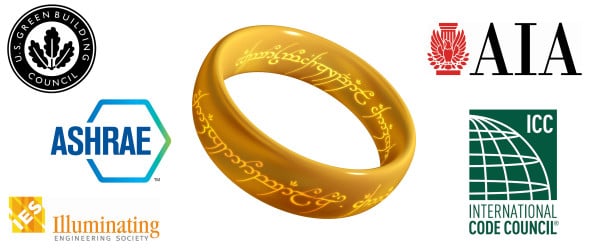Note: This article was orginally published in August, 2014 at AECforensics.com and is reprinted below with full permission.
Finally, after years of confusing and often conflicting standards for the design and construction of sustainable and high performance buildings, it seems we will eventually have “one standard to rule them all.” In an unprecedented move, the five leading developers of building standards have reached an agreement to collaborate on a single standard, divided into three parts. Be forewarned—this article is a veritable alphabet soup of acronyms which I will try to break down.
Paula Melton reports at Environmental Building News that a new consensus-based standard for green buildings will be published as early as 2017 for nonresidential buildings. The primary goal is to develop a standard that will simplify adoption by local building jurisdictions, thereby becoming law governing how projects are designed and constructed.
The five organizations involved:
- ASHRAE – formerly known as the American Society of Heating, Refrigeration and Air-Conditioning Engineers
- AIA – the American Institute of Architects
- ICC – the International Code Council
- USGBC – the United States Green Building Council
- IES – the Illuminating Engineering Society
The standards that will be merged:
- ASHRAE 189.1 – properly known as ANSI/ASHRAE/IES/USGBC Standard 189.1, Standard for the Design of High-Performance Green Buildings Except Low-Rise Residential Buildings
- IgCC – the ICC’s International Green Construction Code
- LEED – Leadership in Energy and Environmental Design
What This Means
In practical terms, the five organizations will build a steering committee to guide the overall standard development. It appears that the agreement represents some compromises on the part of each organization, but will hopefully end the confusion that has resulted from years of competing standards.
According to Melton, the ASHRAE 189.1 standard “will provide baseline metrics and other technical requirements that align with LEED prerequisites and the IgCC. The standard will likely draw some technical requirements from LEED, but it will maintain its own consensus process under ANSI.” According to ASHRAE president Tom Phoenix, “189 is basically at the center of the green-standard world.” However, it also means that for ASHRAE, “now we’re not the sole control like we have been in the past—but that’s OK. These are the recognized leaders in this world, and the fact that we’re all coming together is very exciting.”
The ASHRAE 189.1 standard will serve as a foundation for some of the technical requirements in future versions of the USGBC’s LEED rating system, or at least provide an alternative compliance path. This is an extremely important development, due to significant political pressure from lobbyists working for chemical and timber companies. These groups have sought invalidate LEED by requiring that green building standards must be approved by an organization such as ANSI, the American National Standards Institute. Since 189.1 is ANSI-approved, the hope is that attacks on LEED will be lessened.
Furthermore, ASHRAE, IES and the USGBC will continue to sponsor ICC’s International Green Construction Code (IgCC). However, the IgCC itself will simply “become an adoptable, code-enforceable version of 189.1.” One of the primary goals all along with IgCC has been to make adoption of green building standards by local jurisdictions as simple as possible.
Many jurisdictions that sought to be more proactive in enforcing sustainable practices, adopted LEED as a framework. As a result of this new partnership, while LEED will remain a voluntary rating system, by basing LEED prerequisites on 189.1, it means that LEED will be easier for project teams to achieve in jurisdictions where IgCC has been adopted. In California, for example, our CalGREEN standards mean that for many situations, building to code brings a project within easy reach of LEED Gold certification.
The Copyright Issue
Once this agreement comes to fruition in the form of building codes and standards that can then be adopted as law by various jurisdictions, the unfortunately very ugly issue of copyright is likely to become an issue. Why is this an issue?
Selling copies of building codes/standards is a major source of revenue for those organizations named. So-called rogue archivist Carl Malamud of Public.Resource.Org has been challenging the issue of copyrighting laws for many years now. Malamud has regularly published digital versions of various building codes online, much to the chagrin of the publishers of those organizations, eventually leading to legal action. In the ensuing Veeck v. Southern Building Code Congress Int’l, Inc., 293 F.3d 791 (5th Cir. 2002), the Court ruled that, “as law, the model codes enter the public domain and are not subject to the copyright holder’s exclusive prerogatives.”
In an interview with Malamud published in New Republic, Lydia DePillis noted:
Money is at the heart of most fights over open access to public resources. The federal court system, for example, charges 10 cents per page through PACER because the website generates about $100 million for upgrades to courtroom technology. Malamud had worked with internet activist Aaron Swartz, who committed suicide in January, to “liberate” millions of PACER documents…
Same goes for state regulations that legal information services like LexisNexis and Westlaw now hold exclusive rights to distribute. Governments haven’t had the technical capabilities to maintain their own online legal databases, so they license them to private companies, which results in web pages that can’t be linked to or searched (if there’s a public version at all)…
Malamud thinks the standards development organizations could probably find a way to make it work. He points to the organizations’ high executive salary packages—Shannon made $1.04 million in 2011, and ASTM president James Thomas made $914,000—and suggests they could compensate for lost revenue by doing more training and certification, selling deluxe editions, and charging higher membership fees. “There is lots of money sloshing around the system, including plenty to pay for public access,” he says. Plus, when the NFPA did make the codes available for free in read-only format, it didn’t see a big decrease in print sales. It’s possible that customers would still want the dead tree version, even if the group gave up its copyright entirely. (Columbia University administrative law expert Professor Peter Strauss, who is also advising Malamud, has put together a comprehensive set of proposals for how this might be accomplished.)
Conclusion
Regardless of the copyright issue, the move to streamline, consolidate and ultimately build consensus within the industry is no small feat. That’s why the standard is currently only being investigated with regard to nonresidential projects. All five organizations are waiting to see the fruits of this effort before committing to work on a residential standard.
Instead of one standards body fighting with others for shelf space on the bookcases of design and construction professionals everywhere, we can hopefully move forward as an industry to accomplish the real task at hand:
Building better buildings that use less resources yet still add value, enhance the quality of life for occupants and end users, and ultimately help make the world a better place.
Author: Brian Hill
Resources:
- One Standard to Rule Them All: LEED, IgCC, 189.1 to Be Parts of Single System – Environmental Building News
- New Effort Will Streamline Green Building Standards – Green Building Advisor
- Want to Read the Law? It’ll Cost You. The fight to make building regulations truly free – New Republic
- VEECK v. SOUTHERN BUILDING CODE CONGRESS INTERNATIONAL, INC., 293 F.3d 791 (5th Cir. 2002) – Law.Cornell.edu

Image based on Unico Anello” by Xander – own work, (not derivative from the movies). Licensed under Public domain via Wikimedia Commons
This article was originally published by Xpera Group which is now part of The Vertex Companies, LLC.



